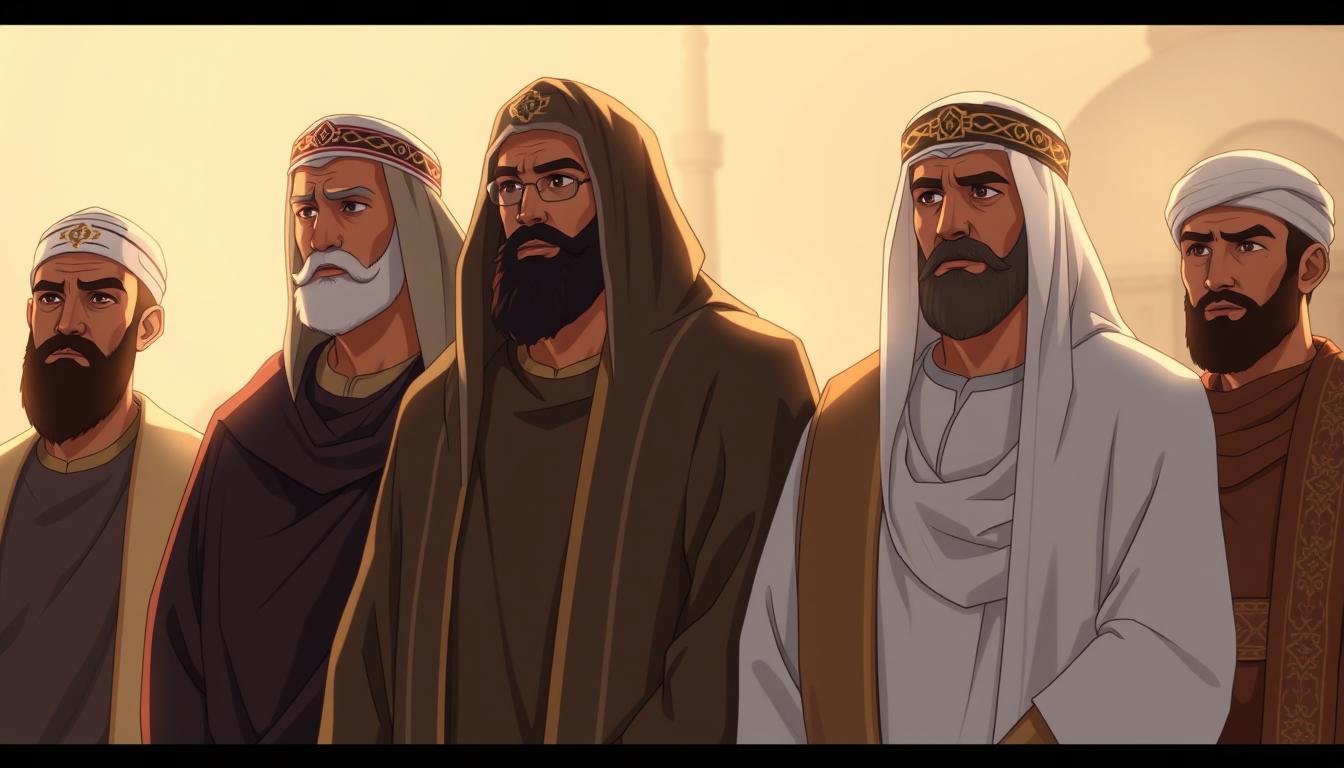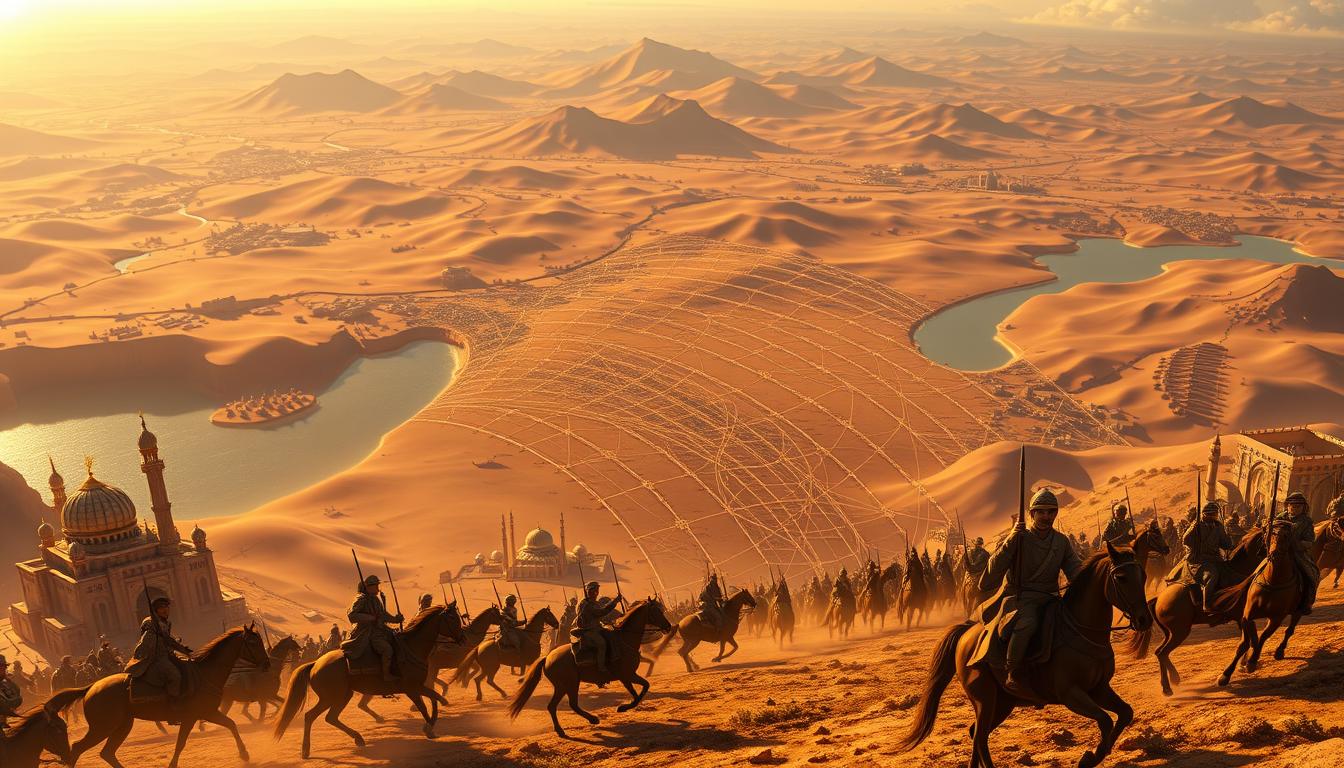Who were the rightful successors of Prophet Muhammad, and how did they shape the future of Islam? The period after the Prophet’s death was key. The Four Khalifas of Islam: A Comprehensive Guide.
It marked the start of the Islamic caliphate under the four khalifas.
We will look into the lives and legacies of these important figures. Known as the four khalifas, they were key in growing and stabilizing the Islamic world. Their leadership and choices greatly impacted Islamic history and still shape the faith today.

Learning about their stories gives us a deep look into Islam’s early days. It shows us the challenges the community faced after the Prophet’s death.
Key Takeaways
- The four khalifas were the primary successors of Prophet Muhammad.
- They played a crucial role in shaping early Islamic history.
- Their leadership expanded the Islamic caliphate.
- Their legacies continue to influence Islam today.
- Understanding their stories offers insights into the challenges faced by the early Islamic community.
The Historical Context of the Caliphate
When Prophet Muhammad passed away, a big question arose about who should lead the Muslims next. The community was in shock and needed to figure out who would guide them after their beloved prophet.
The Death of Prophet Muhammad and the Need for Succession
Prophet Muhammad’s death in 632 CE was a huge blow to the Muslim community. He had been their spiritual and political leader since the start of Islam. His passing left the community in a tough spot, needing a new leader to lead them forward.
The Concept of Khalifa in Islam
The term “Khalifa” means the successor or deputy of Prophet Muhammad. In Islam, the Khalifa is not seen as a prophet but as a leader. They are expected to follow Islam’s principles and guide the community. This idea comes from the Quran and Hadith, showing the importance of fair leadership.
The Establishment of the Rashidun Caliphate
After Prophet Muhammad’s death, Abu Bakr was chosen as the first caliph. The Rashidun Caliphate, lasting from 632 to 661 CE, was a key time in Islamic history. It was led by four Rightly Guided Caliphs: Abu Bakr, Umar ibn al-Khattab, Uthman ibn Affan, and Ali ibn Abu Talib. Their leadership helped grow the Islamic state and set up a system based on Islamic values.
The Four Khalifa of Islam: An Overview
The Four Khalifas of Islam, also known as the Rashidun Caliphs, were key figures in early Islam. They followed Prophet Muhammad and led with justice and wisdom.

The Succession Order and Timeline
The Four Khalifas took turns leading: Abu Bakr, Umar ibn al-Khattab, Uthman ibn Affan, and Ali ibn Abu Talib. Their rule lasted about 30 years, from 632 to 661 CE. This era is called the Rashidun Caliphate.
- Abu Bakr (632-634 CE): Unified the Arabian Peninsula
- Umar ibn al-Khattab (634-644 CE): Expanded the Islamic empire significantly
- Uthman ibn Affan (644-656 CE): Continued expansion and established a unified Islamic state
- Ali ibn Abu Talib (656-661 CE): Faced internal conflicts and civil wars
The Significance of the Rashidun Period
The Rashidun period is a golden era in Islamic history. It was known for justice, compassion, and wise leadership. The Four Khalifas followed Islamic principles and led with integrity.
“The best of you are those who are best to their families, and I am the best of you to my family.”
Common Characteristics of the Four Rightly-Guided Caliphs
The Four Khalifas shared key traits in their leadership. These included:
- Commitment to Justice: They made fair and just decisions.
- Compassion and Empathy: They were kind and cared for their people.
- Adherence to Islamic Principles: They ruled based on Islamic teachings.
In conclusion, the Four Khalifas of Islam set a high standard for leadership. Their legacy inspires Muslims worldwide.
Abu Bakr: The First Khalifa
After Prophet Muhammad passed away, Abu Bakr was chosen as his successor. This marked the beginning of a new era for Muslims. It was a crucial moment, setting the stage for the Islamic community’s leadership.
Early Life and Conversion to Islam
Abu Bakr was one of the first to embrace Islam. He was known for his unwavering faith and close bond with Prophet Muhammad. His conversion was significant, bringing a respected Quraysh tribe member into the Islamic fold.

Selection as the First Caliph
Choosing Abu Bakr as the first caliph was a critical decision. The Muslim community needed a leader after Prophet Muhammad’s death. Abu Bakr’s integrity, wisdom, and close ties to the Prophet made him the perfect choice.
Major Achievements and Challenges
Abu Bakr’s reign was filled with achievements and challenges. Two key events were the Ridda Wars and the compilation of the Quran.
The Ridda Wars
The Ridda Wars were a series of battles to quell rebellions and apostasy among Arabian tribes. Abu Bakr’s leadership ensured the unity and stability of the Islamic state.
Compilation of the Quran
Abu Bakr oversaw the Quran’s compilation, a crucial task for preserving Prophet Muhammad’s revelations. This was a major step in standardizing the Islamic scripture.
| Event | Description | Significance |
|---|---|---|
| Ridda Wars | Military campaigns against rebellious tribes | Ensured unity and stability of the Islamic state |
| Compilation of the Quran | Standardization of Islamic scripture | Preserved the revelations received by Prophet Muhammad |
Leadership Style and Legacy
Abu Bakr’s leadership was marked by humility, justice, and strict adherence to Islam. His legacy as the first caliph and Prophet’s companion is deeply revered in Islamic history.
In conclusion, Abu Bakr’s role as the first Khalifa was crucial in shaping the Islamic community’s future. His leadership during a time of transition and turmoil set a strong precedent for future caliphs.
Umar ibn al-Khattab: The Second Khalifa
Umar ibn al-Khattab was the second leader of the Four Khalifas of Islam. He made a big impact on the Islamic state. His time as caliph saw the state grow and new ways of governing were introduced.
Background and Path to Islam
Umar ibn al-Khattab was once against Islam but later became a strong supporter. His joining the faith was a big deal for the early Muslims. His bravery and smart thinking helped Islam grow and survive.
Appointment as Caliph
After Abu Bakr died, Umar ibn al-Khattab became the second caliph. This choice was made by Abu Bakr himself. Umar’s leadership and his bond with the Prophet Muhammad made him perfect for the job.
Key Accomplishments During His Rule
Umar’s time as caliph was filled with achievements that shaped the Islamic state.
Territorial Expansions
Under Umar, the Islamic state grew a lot. It took over big parts of the Byzantine and Sassanid empires. The wins in Syria, Egypt, and Persia increased the state’s size and wealth.

Umar also made big changes in how the state was run. He set up a fair court system, a strong administration, and a system to help the poor. These changes helped keep the state in order and cared for its people.
Character and Governance Approach
Umar ibn al-Khattab was known for his fairness and simplicity. He stayed close to his people, listening to their problems. He was all about being accountable and following Islam’s teachings.
Uthman ibn Affan: The Third Khalifa
Uthman ibn Affan was known for his piety and leadership. He led the Islamic empire from 644 to 656 CE. His time in power was marked by great achievements that shaped the Islamic world.
Life Before the Caliphate
Before becoming Khalifa, Uthman was wealthy and wise in business. He was one of the first to convert to Islam. His marriage to Ruqayyah, the Prophet Muhammad’s daughter, made him a key figure in the community.
Rise to Leadership
Uthman was chosen as the third Khalifa after Umar ibn al-Khattab’s death. The senior companions of the Prophet chose him, showing the early Islamic government’s democratic nature.
Notable Contributions and Policies
During his time, Uthman made several important policies for the Islamic empire.
Standardization of the Quran
Uthman’s biggest achievement was making the Quran standard. He saw the need for one version of the Quran across the empire. This ensured unity in Islamic scripture.
Expansion of the Islamic Empire
Uthman led the empire to expand into new lands. Military victories added regions like North Africa and Persia to the empire.
| Region | Year of Conquest | Notable Events |
|---|---|---|
| North Africa | 647 CE | Conquest of Tripolitania |
| Persia | 650 CE | Final subjugation of the Sassanian Empire |
| Armenia | 653 CE | Incorporation into the Islamic Empire |
Challenges and Controversies
Uthman’s rule faced challenges. Criticisms about his family appointments and leniency towards them caused discontent. These issues led to his assassination.

Uthman’s legacy is complex. He made significant contributions to the Islamic world but faced challenges. His standardization of the Quran is a lasting achievement.
Ali ibn Abu Talib: The Fourth Khalifa
Ali ibn Abu Talib was the fourth and final Rightly-Guided Caliph. He faced many challenges that tested his wisdom and resolve. His time as caliph was marked by important events that shaped Islam’s future.
Early Life and Relationship with Prophet Muhammad
Ali was born into a noble family in Mecca. He was the son of Abu Talib, Prophet Muhammad’s uncle. Ali’s early life was deeply intertwined with the Prophet’s, as he was raised under Muhammad’s care after being taken in by his uncle. This close relationship made Ali one of the earliest converts to Islam, showing his strong faith and commitment.
Ali’s bond with Prophet Muhammad was more than just family. He was known for his bravery, wisdom, and unwavering dedication to Islam. He married Fatimah, the Prophet’s daughter, further solidifying his close connection to Muhammad.
Ascension to the Caliphate
After Uthman ibn Affan’s assassination, Ali ibn Abu Talib was chosen as his successor. His ascension was met with both support and opposition, reflecting the divisive political climate of the time. Ali’s caliphate began in 656 CE, a period marked by turmoil and conflict.
Major Events During His Rule
Ali’s rule was marked by significant challenges, most notably the First Fitna, or civil war. This conflict erupted due to political and religious divisions within the Muslim community.
The First Fitna (Civil War)
The First Fitna was a pivotal event during Ali’s caliphate. It involved conflicts with other prominent companions, including Aisha, Talhah, and Zubair. This period of civil strife tested Ali’s leadership and his ability to maintain unity among Muslims. Despite his efforts to negotiate peace, the conflict escalated, leading to significant consequences for the Muslim community.
Political and Social Reforms
Despite the turmoil, Ali ibn Abu Talib implemented various political and social reforms. He emphasized the importance of adhering to Islamic principles in governance, striving to create a fair and just society.
Wisdom and Leadership Qualities
Ali ibn Abu Talib was renowned for his wisdom, courage, and strong sense of justice. His leadership was characterized by a deep commitment to Islamic values, and he is remembered as a just and fair ruler. Ali’s ability to balance compassion with firmness in governance earned him respect from his contemporaries and subsequent generations.
Throughout his life, Ali ibn Abu Talib remained dedicated to the principles of Islam. He served as a role model for Muslims. His legacy continues to inspire and guide those seeking to understand the true essence of Islamic leadership and governance.
The Collective Legacy of the Four Khalifas
Understanding the legacy of the Four Rightly-Guided Caliphs is key to knowing early Islam. Their leadership and vision greatly influenced the Islamic world. They shaped many aspects of the religion and its community.
Religious Developments and Preservation
The Four Khalifas were crucial in preserving and developing Islam. They compiled the Quran into one manuscript to keep it intact. The compilation of the Quran under their rule ensured the holy book stayed unchanged for Muslims.
They also supported spreading Islam through missionary work and setting up Islamic institutions. Their efforts helped consolidate Islamic practices and foster a unified faith.
Political and Administrative Foundations
The Four Khalifas set the stage for a strong political and administrative system. They created a structured government with clear roles. This helped manage the growing Islamic state.
| Caliph | Administrative Reforms | Notable Achievements |
|---|---|---|
| Abu Bakr | Unified the Arabian Peninsula | Suppressed apostasy movements |
| Umar ibn al-Khattab | Established a robust administrative system | Expanded Islamic territories |
| Uthman ibn Affan | Standardized the Quran | Oversaw significant infrastructure projects |
| Ali ibn Abu Talib | Focused on justice and equality | Navigated internal conflicts |
Social and Economic Contributions
The caliphs made many social and economic reforms that impacted the Islamic community. They established a welfare system for the poor and promoted trade and prosperity through their economic policies.
They also worked on social justice, focusing on equality and fairness. Their leadership helped create a more just society.
Military Expansions and Conquests
The Four Khalifas led many military campaigns that expanded the Islamic state. They conquered new territories, including parts of the Byzantine and Sassanian Empires.
These military expansions spread Islam and led to cultural and economic exchanges between regions.
How to Apply the Wisdom of the Four Khalifas Today
Reflecting on the lives of the four khalifas, we find valuable lessons for today’s Muslims. These leaders, known for their strong leadership and Islamic values, offer insights for today’s challenges.
Governance Principles for Modern Muslims
The four khalifas showed us the importance of justice, fairness, and consultation. For example, Abu Bakr’s focus on equality and the rule of law is key to Islamic governance. Today, we can follow their lead by promoting transparency and accountability in our communities.
They also valued shura, or consultation, in making decisions. This principle helps us today by encouraging collaborative leadership and seeking input from all.
Ethical Lessons from Their Lives
The four khalifas’ lives teach us about justice, compassion, and humility. Their examples are crucial for Muslims facing today’s challenges. For instance, Umar ibn al-Khattab’s creation of a welfare system shows the importance of social justice.
They were known for their integrity and honesty. Uthman ibn Affan’s fair business practices before becoming caliph highlight the value of ethical behavior in all aspects of life.
Implementing Their Leadership Qualities in Daily Life
The leadership qualities of the four khalifas, like courage and wisdom, are worth emulating. Modern Muslims can show courage in standing up for their rights and others. They can also make wise decisions in their personal and professional lives.
Ali ibn Abu Talib’s bravery and wisdom in tough times offer a great example for today’s Muslims. By learning from them, we can develop the leadership skills needed to tackle today’s problems.
Addressing Contemporary Challenges Through Their Examples
The four khalifas’ examples guide us on tackling today’s challenges, from inequality to political instability. By studying their governance, ethics, and leadership, we can find effective solutions for these issues.
In conclusion, the wisdom of the four khalifas is a treasure trove of guidance for modern Muslims. By applying their principles, lessons, and qualities, we can face today’s complexities with confidence and integrity.
Conclusion
The four khalifa of Islam were key figures after the Prophet Muhammad. They helped build a strong Muslim community. Their leadership made the Islamic world grow and thrive.
Looking back, we see how crucial justice, compassion, and wise leadership are. The khalifa showed us how to lead well. Their stories teach us about good governance and community building.
The legacy of the four khalifa inspires Muslims everywhere. Their dedication to Islam and leadership is still guiding us. As we aim to create better communities, their wisdom is invaluable.
FAQ
Who were the four khalifas of Islam?
The four khalifas, or Rightly Guided Caliphs, were Abu Bakr, Umar ibn al-Khattab, Uthman ibn Affan, and Ali ibn Abu Talib. They led the Muslim community after Prophet Muhammad.
What is the significance of the Rashidun Caliphate in Islamic history?
The Rashidun Caliphate is key because it started the Islamic state after Prophet Muhammad’s death. It laid the groundwork for Islam’s spread and the growth of Islamic governance.
What were some of the major achievements of the four khalifas?
The four khalifas made big strides. They compiled the Quran, expanded territories, brought new governance ideas, and created a fair system. Their work deeply influenced the Muslim world.
How did the four khalifas contribute to the preservation of Islam?
They were crucial in keeping Islam alive. They ensured the Quran’s standardization, spread Prophet Muhammad’s teachings, and built a strong Muslim community base.
What lessons can be learned from the leadership of the four khalifas?
Their leadership teaches us about good governance, justice, kindness, and wise decision-making. These lessons help Muslims lead with integrity and fairness today.
How did the four khalifas handle challenges and controversies during their rule?
They faced many challenges, like the Ridda Wars and the First Fitna. They used their wisdom, consulted with others, and stayed committed to justice to overcome these issues.
What is the relevance of the four khalifas to modern Muslims?
The four khalifas are still important today. They show us what true leadership, integrity, and justice look like. They guide us in facing today’s challenges and building strong communities.


